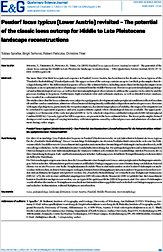| dc.contributor.author | Sprafke, Tobias | |
| dc.contributor.author | Terhorst, Birgit | |
| dc.contributor.author | Peticzka, Robert | |
| dc.contributor.author | Thiel, Christine | |
| dc.date.accessioned | 2013-06-17T20:06:22Z | |
| dc.date.available | 2013-06-17T20:06:22Z | |
| dc.date.issued | 2013-06-17 | |
| dc.identifier.citation | E&G – Quaternary Science Journal; Vol.62, No.1, p.59-72 | |
| dc.identifier.uri | http://hdl.handle.net/11858/00-1735-0000-001F-3300-E | |
| dc.description.abstract | The more than 12 m thick loess-paleosol sequence in Paudorf, Lower Austria, has been known for decades as locus typicus of the “Paudorfer Bodenbildung” (Paudorf paleosol). The upper section of the outcrop contains an up to 1 m thick pedocomplex that developed during MIS 5. The differentiated sequence of loess-like sediment below, including a more than 2 m thick pedocomplex in its basal part, is an exceptional archive of landscape evolution from the Middle Pleistocene. Herein we present detailed paleopedological and sedimentological surveys, as well as first micromorphological observations to address the sequence in its entirety and the processes leading to its genesis. Furthermore, high resolution color and carbonate analyses, as well as detailed texture analyses, have resulted in a substantial database.
The studies show that the loess sediments were subject to a polygenetic development under periglacial conditions reflected in eolian silt and fine sand accumulation, admixture of local material during (mostly solifluidal) redeposition and in situ processes. Horizons with signs of pedogenesis, particularly the two pedocomplexes, document longer phases of stability; the stages of development can be correlated to equivalent sequences and seen as paleoclimatic signals where chronological data are available. The upper pedocomplex is a Chernozem of the early last glacial (MIS 5c–[a?]), which developed in a solifluidal redeposited (MIS 5d) interglacial Cambisol (MIS 5e). Cryosols, typical for MIS 6 sequences, are present in the loess sediment below. The lower pedocomplex formed during several warm stages of varying intensities, with interruptions caused by colluvial processes and admixture of eolian sediment during colder stages. | |
| dc.language.iso | eng | |
| dc.publisher | Geozon Science Media | |
| dc.relation.ispartofseries | E&G | |
| dc.subject.ddc | 551 | |
| dc.title | Paudorf locus typicus (Lower Austria) revisited | |
| dc.type | article | |
| dc.bibliographicCitation.volume | 62 | |
| dc.bibliographicCitation.issue | 1 | |
| dc.bibliographicCitation.firstPage | 59 | |
| dc.bibliographicCitation.lastPage | 72 | |
| dc.identifier.doi | 10.23689/fidgeo-1938 | |
| dc.type.version | Verlagsversion | |
| dc.rights.holder | Geozon Science Media | |
| dc.date.updated | 2013-06-17T20:06:22Z | |
| dc.subject.free | micromorphology | |
| dc.subject.free | loess | |
| dc.subject.free | lower austria | |
| dc.subject.free | paudorf | |
| dc.subject.free | middle pleistocene | |
| dc.subject.free | paleopedology | |
| dc.subject.free | landscape formation | |
| dc.relation.volume | E&G – Quaternary Science Journal; Vol.62 | |
| dc.bibliographicCitation.journal | E&G | |
| dc.relation.collection | Geologische Wissenschaften | |
| dc.description.type | research | |


